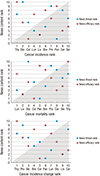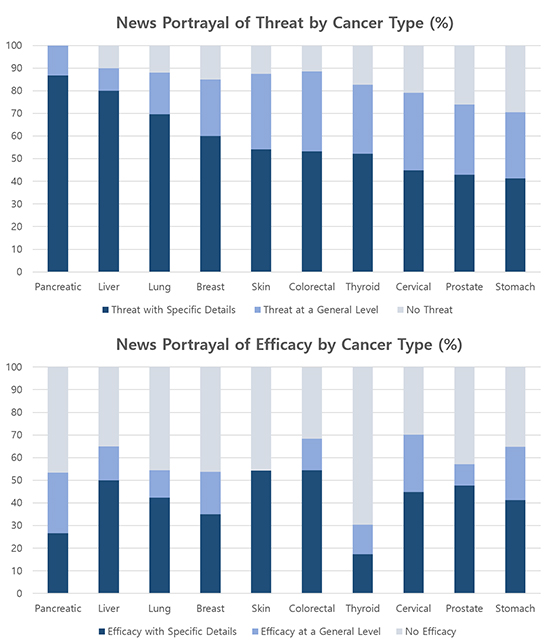1. Cohen EL, Caburnay CA, Luke DA, Rodgers S, Cameron GT, Kreuter MW. Cancer coverage in general-audience and black newspapers. Health Commun. 2008; 23:427–435.
2. Freimuth VS, Greenberg RH, DeWitt J, Romano RM. Covering cancer: newspapers and the public interest. J Commun. 1984; 34:62–73.
3. Jensen JD, Moriarty CM, Hurley RJ, Stryker JE. Making sense of cancer news coverage trends: a comparison of three comprehensive content analyses. J Health Commun. 2010; 15:136–151.
4. Ju Y, Jeong DE, You M. The representation of cancer risk by Korean health journalism: comparing the crude rates of 10 cancers to the amount of cancer news in the three major newspapers (1990-2010). J Korean Soc Health Educ Promot. 2013; 12:201–210.
5. Kye SY, Kwon JH, Kim YC, Shim M, Kim JH, Cho H, Jung KW, Park K. Cancer risk factors in Korean news media: a content analysis. Asian Pac J Cancer Prev. 2015; 16:731–736.
6. Slater MD, Long M, Bettinghaus EP, Reineke JB. News coverage of cancer in the United States: a national sample of newspapers, television, and magazines. J Health Commun. 2008; 13:523–537.
7. Jensen JD, Scherr CL, Brown N, Jones C, Christy K. Public perception of cancer survival rankings. Health Educ Behav. 2013; 40:721–729.
8. Jensen JD, Scherr CL, Brown N, Jones C, Christy K, Hurley RJ. Public estimates of cancer frequency: cancer incidence perceptions mirror distorted media depictions. J Health Commun. 2014; 19:609–624.
9. Kim S, Shin DW, Yang HK, Kim SY, Ko YJ, Cho B, Lee YS, Lee D, Park K, Park JH. Public perceptions on cancer incidence and survival: a nation-wide survey in Korea. Cancer Res Treat. 2016; 48:775–788.
10. Kelly B, Hornik R, Romantan A, Schwartz JS, Armstrong K, DeMichele A, Fishbein M, Gray S, Hull S, Kim A, et al. Cancer information scanning and seeking in the general population. J Health Commun. 2010; 15:734–753.
11. Shim M, Kelly B, Hornik R. Cancer information scanning and seeking behavior is associated with knowledge, lifestyle choices, and screening. J Health Commun. 2006; 11:Suppl 1. 157–172.
12. Niederdeppe J, Fowler EF, Goldstein K, Pribble J. Does local television news coverage cultivate fatalistic beliefs about cancer prevention? J Commun. 2010; 60:230–253.
13. Niederdeppe J, Lee T, Robbins R, Kim HK, Kresovich A, Kirshenblat D, Standridge K, Clarke CE, Jensen J, Fowler EF. Content and effects of news stories about uncertain cancer causes and preventive behaviors. Health Commun. 2014; 29:332–346.
14. Witte K. Putting the fear back into fear appeals: the extended parallel process model. Commun Monogr. 1992; 59:329–349.
15. Witte K. Fear control and danger control: a test of the extended parallel process model (EPPM). Commun Monogr. 1994; 61:113–134.
16. Roskos-Ewoldsen DR, Yu JH, Rhodes N. Fear appeal messages affect accessibility of attitudes toward the threat and adaptive behaviors. Commun Monogr. 2004; 71:49–69.
17. Cho H, Witte K. Managing fear in public health campaigns: a theory-based formative evaluation process. Health Promot Pract. 2005; 6:482–490.
18. Cohen EL, Shumate MD, Gold A. Original: anti-smoking media campaign messages: theory and practice. Health Commun. 2007; 22:91–102.
19. Goodall C, Sabo J, Cline R, Egbert N. Threat, efficacy, and uncertainty in the first 5 months of national print and electronic news coverage of the H1N1 virus. J Health Commun. 2012; 17:338–355.
20. Turner MM, Boudewyns V, Kirby-Straker R, Telfer J. A double dose of fear: a theory-based content analysis of news articles surrounding the 2006 cough syrup contamination crisis in Panama. Risk Manag. 2013; 15:79–99.
23. Jung KW, Won YJ, Kong HJ, Oh CM, Cho H, Lee DH, Lee KH. Cancer statistics in Korea: incidence, mortality, survival, and prevalence in 2012. Cancer Res Treat. 2015; 47:127–141.
24. Stryker JE, Emmons KM, Viswanath K. Uncovering differences across the cancer control continuum: a comparison of ethnic and mainstream cancer newspaper stories. Prev Med. 2007; 44:20–25.
25. Clarke JN, Everest MM. Cancer in the mass print media: fear, uncertainty and the medical model. Soc Sci Med. 2006; 62:2591–2600.









 PDF
PDF ePub
ePub Citation
Citation Print
Print




 XML Download
XML Download